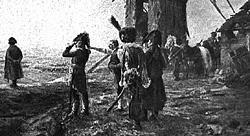
200 YEARS AGO
16 May, 1795: Treaty of Basle. Spain admits defeat at the hands of the Revolutionary armies. Moncey had penetrated as far as Bilbao, and Perignon had conquered Catalonia up to and including the fortress city of Rosas. The French wanted the maritime strength of Spain to use against England, and needed to redeploy their armies from the Pyrenees to support Augereau in the Alps. The real winner was Godoy, whose power in Spain was cemented by this successful peace. He is created "Prince of Peace." 21 June: Landing at Quiberon. The British suffer an amphibious debacle on the west coast of France. 3,500 émigré troops are landed to support Royalist sympathisers in Brittany and the Vendee, but the rising is put down by General Hoche, and only a few invaders survive to be evacuated by the Royal Navy.
190 YEARS AGO
26 May, 1805: Napoleon crowns himself King of Italy, and appoints his step-son Eugene Beauharnais his Viceroy on 7 June. However, his limited sense of what Italy can be is shown by his annexation of Genoa into France on 4 June.
180 YEARS AGO
March-June, 1815: After his return from exile at Elba, Napoleon makes war preparations. He reorganizes the French army, once more displaying his amazing efficiency. By early June, he has a field force of 188,000 regulars ready to move with another 100,000 in depots and fortresses. In addition, some 300,000 are in training. In his Armee du Nord (Army of the North), Napoleon has 124,000 men concentrated around Paris. Other forces guard the frontier.
1 June: The Allied armies begin to concentrate on the French borders: (1) In Belgium: Wellington's Anglo-Allied army of 95,000 men, and Blücher's Prussian army of 124,000 men. (2) In Luxembourg: Kleist's Corps of 26,000 men. (3) On the Rhine between Mannheim and Basle: Schwarzenberg's army (primarily Austrians) of 210,000 men. (4) In central Germany: 167,000 Russians move slowly toward France. (5) In northeast Italy: Frimont's army of 75,000 men.
1 June: Napoleon knows that the Allies cannot unleash their full power before mid-July. In accordance with his strategy to defeat his enemies in detail before they can concentrate, he decides to strike first and takes the offensive. He plans to crush the nearest threat first, the Allied armies in Belgium.
11-14 June: In four days, Napoleon concentrates his army in the north of France, south of Charleroi. He is in a position to strike Wellington and Blücher before they learn that the French army has left its cantonments near Paris.
15 June: Napoleon strikes at Charleroi. Blücher reacts quickly and by evening has concentrated three of his four Prussian corps near Sombreffe some ten miles north-east of Charleroi. The more cautious Wellington, fearing for his line of communications, decides to concentrate further north of Charleroi at the Quatre-Bras crossroad.
16 June: Napoleon orders Ney to capture Quatre-Bras with 25,000 men, while he attacks Blücher at Ligny with about 77,000 men. Ney fails to capture Quatre-Bras but Napoleon defeats Blücher by shattering the Prussian center.
17 June: Tardy pursuits of Wellington by Ney and of Blücher by Grouchy.
18 June: Battle of Waterloo. Napoleon is defeated by the combined forces of Wellington and Blücher.
18-19 June: Grouchy attacks the Prussians at Wavre. On the 19th, Grouchy learns that Napoleon has been defeated at Waterloo. He decides to withdraw by way of Namur. The French army withdraws to Paris to make a stand there.
21 June: Napoleon abdicates and surrenders to the British.
Back to Empires, Eagles, & Lions Table of Contents #12
Back to Empires, Eagles, & Lions List of Issues
Back to MagWeb Master Magazine List
© Copyright 1995 by The Emperor's Press
This article appears in MagWeb (Magazine Web) on the Internet World Wide Web.
Other military history articles and gaming articles are available at http://www.magweb.com